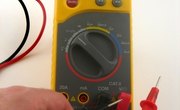
All boats with electric start engines have a starter solenoid through which the electricity flows from the battery to the starter motor. If you turn the ignition key to the start position and nothing happens, you may be having a solenoid problem. Luckily, troubleshooting, repair or replacement of solenoids is routine work for a DIY inclined boat owner.
Understanding Solenoids
Lights, radios and most other electrical gear on a boat draw relatively little power and their electrical input is easily wired through switches between the power source and the items. A starter motor, however, may draw as many as 500 amperes when turning over a large engine. Heavy wire cable (often 3/0) is required to carry that much load safely.
A switch in a 3/0 cable would be huge–hardly something easily key operated. So gasoline and diesel engine starters are switched on/off using an electrically actuated switch called a solenoid. All starter solenoids have three power posts. One is powered directly from the battery with a heavy red electrical cable. The second is the power-out post, which routes electricity to the starter either with heavy red cable leading to the starter or by attaching to a copper strap leading into the starter motor on solenoids mounted atop the starter motor. The third post brings in power from a key switch via a small gauge red and yellow wire. When the key is turned, electricity flows through the red/yellow wire, activating an electro-magnet inside the solenoid which connects the heavy cable from the battery and the cable or strap leading to the starter motor.
Testing the Solenoid
Follow the heavy red wire from the battery. It connects to the solenoid. Ground the clip on the wire end of a 12V test light to a metal part of the engine and touch the tester’s probe to the power-in post from the battery. This post is always hot and will activate the test light regardless of the position of the key switch.
Now touch the probe to the post to which the small-gauge red/yellow wire is attached. It should be cold until a helper turns the key to the start position at which time the test light should turn on. The final test is to touch the probe to the post that connects the solenoid to the starter. Again, have a helper turn the ignition key.
If the test light turns on, the solenoid is working. Either there’s insufficient power (low battery) to run the starter motor or a problem with the starter motor.
Fix or Replace?
Assuming the tests show the solenoid is malfunctioning, meaning the wire from the fully-charged battery is firmly attached, the red/yellow key wire energizes properly but no electricity flows out, there are two options. Solenoids are fairly simple “machines.” Often it’s just corrosion inside, which prevents the contacts from closing making the electrical connection. Solenoids can be often be disassembled, cleaned and returned to full function.
Solenoids are relatively inexpensive, however, so most people purchase and install a replacement.
References
Writer Bio
Mike Schoonveld has been writing since 1989 with magazine credits including "Outdoor Life," "Fur-Fish-Game," "The Rotarian" and numerous regional publications. Schoonveld earned a Master Captain License from the Coast Guard. He holds a Bachelor of Science in wildlife science from Purdue University.



